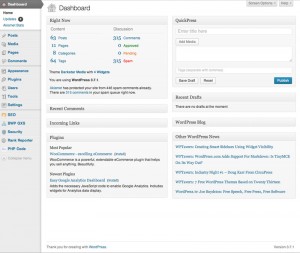 12 years ago, when I started in the web design business I spent a lot of time building static web sites. Most of my time was spent in Photoshop at the design stage of web development. Here, I would export my design as slices in a table layout. From there I would designate a few spots for HTML copy, then add in my Flash and JavaScript elements. For these websites I would usually do any number of requested updates to the site on a certain day of the week and invoice my clients monthly for these changes.
12 years ago, when I started in the web design business I spent a lot of time building static web sites. Most of my time was spent in Photoshop at the design stage of web development. Here, I would export my design as slices in a table layout. From there I would designate a few spots for HTML copy, then add in my Flash and JavaScript elements. For these websites I would usually do any number of requested updates to the site on a certain day of the week and invoice my clients monthly for these changes.
I would also get projects which required having an image gallery, press feed, bulletin board or an e-commerce component. For these I would build a dynamic database driven content management component which would allow the client to manage this content. For these projects I would integrate my static HTML code with the dynamic PHP and MySQL components. On other occasions I would get projects which were company intranets/extranets and all the content was database driven.
Let’s define a content management system. As per Wikipedia a CMS is described as:
“A content management system (CMS) is a computer program that allows publishing, editing and modifying content as well as maintenance from a central interface. Such systems of content management provide procedures to manage workflow in a collaborative environment.[4] These procedures can be manual steps or an automated cascade. CMSs have been available since the late 1990s.”
CMS websites are typically used for content control, user management and tracking, searching and editing data, creating reports, eCommerce, blogging, and publishing a news feed among other functions. There are thousands of CMS systems out there for a variety of website sizes and requirements, and on top of those developers would need to develop plug-ins or an entire custom CMS system.
For websites which were a fusion of database driven content and static HTML code, the Content Management Systems (CMS) component was always an extra item, one that was specifically asked for based on an estimation of how often the content would have to change.
What has changed in the last few years is the emergence of open source projects, sites such as WordPress, Magento, Drupal, and Joomla, to name a few. These sites are free and developed by countless web developers worldwide. I think because of the combination of cost (free) and the input from many developers working towards making the systems easy to use and update, these CMS systems have now become the standard. They are what is expected by web site owners.
This works best for both the developer and the owner. Content updates in the past, which were critical to the website owner to promote or showcase new goods or services, were sometimes inconvenient for a web designer to do immediately, as they were usually in the midst of another project. It makes sense to use a CMS such as WordPress for a small to medium sized website because
- Doing so allows the customer to manage all the text, image, press, products updates themselves
- Website owners have started to expect and reply on this content control.
The critical benefits which Content Management Systems (CMS) offer are greater content control and superior flexibility. Not only do they allow you to update content information on your website more efficiently, they also free you from being tied to a specific developer. With an open source CMS, you can get almost any developer to add functionality to your website.
